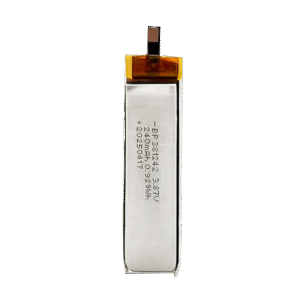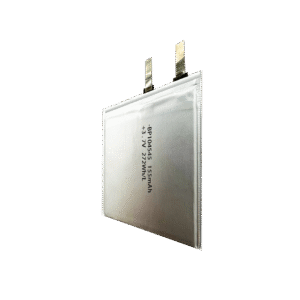Table of Contents
When temperatures drop below freezing, most batteries struggle to deliver their rated performance. Cold weather slows down chemical reactions inside cells, increases internal resistance, and dramatically reduces capacity. For users who rely on lithium batteries in drones, outdoor sensors, or winter vehicles, choosing the right battery type and taking proper precautions can make the difference between smooth operation and sudden power failure.
This guide explains how cold affects lithium batteries, what chemistries perform best, and what you should look for when choosing or using lithium battery for cold weather.
Why Cold Weather Affects Lithium Batteries?
All lithium-based batteries rely on the movement of lithium ions through an electrolyte between the anode and cathode. In cold weather, that movement slows down. As temperature decreases:
- Ion mobility drops, which means fewer ions can move to generate current.
- Internal resistance increases, causing noticeable voltage sag under load.
- Available capacity decreases — you might get only 50–70% of rated runtime at –10 °C (14 °F).
Cold also thickens the electrolyte and can cause lithium plating during charging if cells are too cold. That’s why manufacturers warn against charging below 0 °C (32 °F) — it can permanently damage the cell.
What Temperature Is Bad for Lithium Batteries?
Lithium-ion batteries perform best within an optimal temperature range of 20°C to 25°C (68°F to 77°F). Once the temperature drops below freezing (0°C or 32°F), their performance begins to decline noticeably.
- 0°C to -10°C (32°F to 14°F): Battery capacity decreases moderately, but operation is still possible with limited performance.
- -10°C to -20°C (14°F to -4°F): Efficiency drops sharply, and maintaining sufficient power output becomes difficult.
- Below -20°C (-4°F): The likelihood of permanent damage rises significantly, and charging under these conditions can cause irreversible harm.
At extremely low temperatures, charging poses the greatest risk — metal lithium may form on the anode, potentially leading to internal short circuits and serious safety issues.
LiPo vs. LiFePO₄: Which Is Better for Cold Weather?
Choosing between Lithium Polymer (LiPo) and Lithium Iron Phosphate (LiFePO₄) batteries can be confusing — both are popular lithium chemistries, but they behave very differently in cold environments. The right choice depends not only on temperature tolerance, but also on your specific application, weight requirements, and power demands.
Let’s compare the two across several critical factors:
| Feature | LiPo Battery | LiFePO₄ Battery |
| Energy Density | High | Moderate |
| Low-Temperature Performance | Moderate: usable down to –20 °C with preheating | Excellent: retains capacity to –30 °C with built-in heating |
| Discharge Power | High (great for high-current devices like drones) | Moderate (stable but less peak current) |
| Cycle Life | 500–1000 cycles typical | 2000+ cycles possible |
| Weight | Lightweight, flexible form factor | Heavier and bulkier for the same capacity |
| Safety | Sensitive to overcharge/heat | Chemically stable and safer |
| Ideal Applications | Drones, wearables, robotics, portable devices | RVs, solar systems, cold storage, power backup |
How to Choose Lithium Battery for Cold Weather?
Choose LiPo if your application is:
- Drones / RC Aircraft
- Wearable Devices
- High-Performance RC Cars
- Portable electronic devices where extreme lightweight is critical
In these scenarios, high power-to-weight ratio and minimal size are non-negotiable requirements, and there is no practical substitute. Users must accept their significantly reduced performance in cold weather and strictly adhere to usage and charging protocols (such as warming them to room temperature before charging).
Choose LiFePO₄ if your application is:
- RV/Marine Electrical Systems
- Solar Energy Storage Systems
- Portable Power Stations
- Ice Fishing Equipment, Outdoor Camping Power
- Car Starter Batteries (Auxiliary or Main)
- Any application where the battery is fixed in place and where safety and lifespan are critical
In these scenarios, safety, lifespan, and capacity stability are far more important than lightweight portability. You can easily install the heavier LiFePO₄ batteries in a fixed location and enjoy their reliable service for up to a decade.
Custom Low Temperature Battery Solutions – LanDazzle
Founded in 2018, LanDazzle is a leading lithium manufacturer focusing on the R&D of special shaped lipo battery, low temperature battery and lithium battery pack.

Our Low Temperature Battery Advantages:
- Shape Advantages: With advanced stacking technology, our battery shapes can be extensively customized, providing greater design flexibility and optimizing the use of internal space within devices. This enables the production of small, ultra-thin batteries that not only fit compact or uniquely shaped products but also offer reliable low-temperature performance. Such batteries are ideal for specialized applications, professional smart equipment, and environments where both space efficiency and consistent performance under cold conditions are critical.
- Performance Advantages: Our lithium batteries are engineered to excel in the most demanding cold-weather conditions, delivering exceptional performance where others fail. They boast an outstanding low-temperature discharge performance, maintaining over 60% efficiency even at an extreme -40°C with a 0.5C discharge rate. At a more common -30°C, they deliver up to 80% of their nominal capacity. With a wide operating temperature range of -40°C to 60°C and high safety standards compliant with UL, CE, and UN certifications, these batteries provide reliable and safe power for your most critical applications.
- Weight Advantages: Under identical voltage and capacity specifications, low-temperature Lithium Polymer batteries offer a significant weight advantage over their LiFePO₄ counterparts. This is primarily because LiPo cells utilize a flexible, lightweight pouch design, whereas LiFePO₄ batteries often employ heavier cylindrical or prismatic aluminum casings to house their inherently denser chemistry. This fundamental difference in construction allows LiPo batteries to achieve more compact and space-efficient designs.
How to Charge Lithium Battery in Cold Weather?
Charging is the most critical process for lithium batteries in cold weather. Always follow these best practices:
- Never charge below 0 °C (32 °F).
Charging frozen cells leads to lithium plating and internal shorting. - Warm batteries before charging.
If a battery is cold, bring it indoors and let it reach room temperature gradually. - Use a BMS or charger with temperature protection.
Many modern systems automatically delay charging until the internal temperature is safe. - Charge at lower currents.
A slow charge (e.g., 0.3C–0.5C) generates less stress on cold cells. - Avoid fast charging in winter.
Quick charging amplifies internal heating and can cause uneven lithium deposition.
How to Protect Your Lithium Batteries in Cold Weather?
While cold weather poses a challenge to lithium batteries, you can take proactive steps to ensure optimal performance and longevity throughout the winter. Here are four key strategies for effective cold-weather battery management:
- Prioritize Warm Storage: When not in use, store your batteries in an environment above 10°C (50°F). This simple practice is the most effective way to prevent significant capacity loss and preserve battery health.
- Invest in Insulation: Utilize insulated wraps or thermal blankets to shield batteries from the cold. This creates a barrier that helps maintain a stable internal temperature, slowing heat loss. For maximum convenience, consider models with factory-installed insulation.
- Pre-Warm Before Use: Never use or charge a battery that is ice-cold. If it has been exposed to freezing temperatures, gently warm it first. This can be done by bringing it indoors or employing a dedicated battery warmer.
- Opt for Active Management: For the ultimate protection in harsh climates, select a battery system with an integrated heating function. These advanced units automatically activate to warm the core to an optimal operating temperature, ensuring power is available on demand.
Conclusion
Choosing lithium batteries for cold weather requires understanding how temperature impacts performance and safety. LiPo batteries offer unmatched power-to-weight ratio, making them ideal for compact and high-drain applications — but they must be protected, insulated, and warmed before use. For users operating in extremely cold environments, LiFePO₄ or custom low-temperature LiPo solutions with integrated heaters provide the most dependable results.
Whether you’re powering a drone in Alaska, a camera in Canada, or an outdoor sensor in Colorado, following these cold-weather best practices ensures your lithium batteries stay reliable — even when the temperature drops far below zero.
Ready to find the perfect low temperature battery solution for your products? Contact our team at LanDazzle today to discuss your custom battery needs and discover how our high-performance solutions can power your devices in any environment.
Contact us today to get a free consultation and explore how our custom battery solutions can bring your devices to life.
Email: info@landazzle.com
Whatsapp: +8618938252128
Related Articles:
Low Temperature Battery: How They Work and How to Choose the Right One
Low Temperature Battery fot Action Camera

